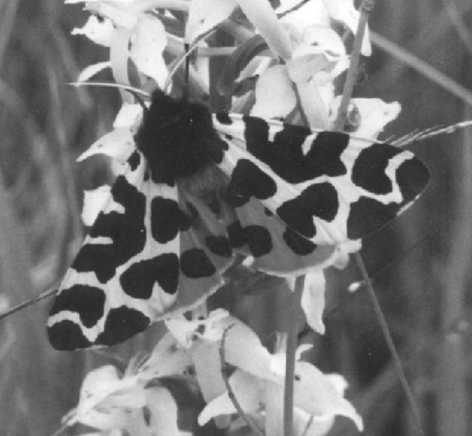People in Worcestershire are being asked to look out for Woolly Bears in their gardens. Woolly Bears are the familiar name for the caterpillars of the striking Garden Tiger moth, which scientists believe to be becoming rarer. National research has shown that in the past thirty years, numbers of the once common Garden Tiger moth have dropped by 44% across Great Britain. Their woolly bear caterpillars were once familiar to children everywhere but scientists fear that they will become a rare sight for future generations. Now members of the West Midlands branch of Butterfly Conservation, the national insect charity, are launching a survey to find out how the Woolly Bear is faring in the region.
Local Moth Officer, Neil Gregory said "Woolly Bears are orange and black in colour and very hairy. They feed on a variety of garden weeds and can be seen basking in the sunshine during May or later crossing paths as they move off to their pupation sites. The adult moth, which is large with brown and white markings and orange underwings, flies at night during July and August and is attracted to light. We are asking that people keep a look out for the caterpillar or moth and let us know if they see it. Sightings can be reported by phoning 01905 771623 or by email to droitwich@btinternet.com We hope to show that, despite the national decline, Tigers are still lurking in the gardens of (county). Photographs of the Garden Tiger and its caterpillar can be viewed on the West Midlands Butterfly Conservation website: www.westmidlandsbutterflyconservation.org.uk"
The decline in numbers of Garden Tigers is mirrored by that of other moths. New figures from the oldest agricultural research station in the world at Rothamsted have revealed devastating declines in numbers of once common moth species. Total numbers of moths recorded from the longest-running light-trap at Rothamsted Research Station in Hertfordshire have declined by over 60% since the 1930s. Preliminary studies of individual moth species across the Rothamsted Insect Survey's extensive national light-trap network have also triggered alarm bells. During the same period, populations of other once commonplace moths such as the Lackey and the Figure of Eight have been decimated - their numbers reduced by 72% and 64% respectively.
Nationally, Butterfly Conservation will now be working with scientists at Rothamsted to discover how hundreds of other moth species are faring, thanks to a new grant from the Esmée Fairbairn Foundation, and the findings from the West Midlands survey will feed into this research.
Dr Martin Warren, Chief Executive of Butterfly Conservation said "The preliminary findings are shocking and suggest that many common moths may be suffering considerable declines. Moths are a vital part of the food chain, and our results will help us understand how serious the knock-on effects of their declines will be for other species."
Ian Woiwod, Head of the Rothamsted Insect Survey, added "We are delighted to be able to expand our research with the help of Butterfly Conservation. Together we will try to identify all the factors contributing to the demise of our moths, such as climate and land use change. There is still much research to be done, but a better understanding of the situation will ensure that we take the correct action to protect these important insects."
For further information contact Neil Gregory on 01905 771623

Garden tiger moth. The underwing is orange with black spots. Photo Neil Gregory